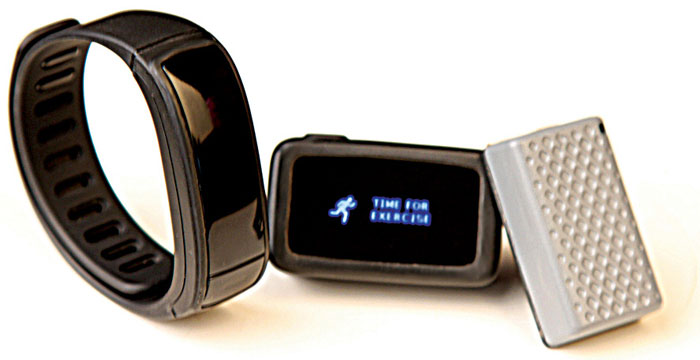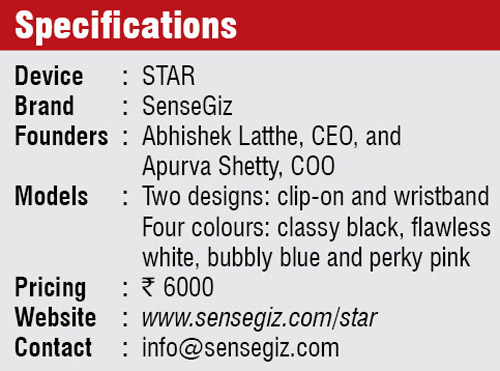Wearable technology has seen tremendous growth in the past year. A recent report on wearable electronics market by Business Insider forecasts that the global wearable devices market will grow at a compound annual rate of 35 per cent over the next five years, reaching 148 million units shipped annually in 2019. Competing with global players in this arena, we now have a wearable band designed and manufactured completely in India.
Founded in 2013, Belgaum based SenseGiz Inc. has come up with STAR, an affordable multi-purpose smartdevice that can be clipped to clothing or worn as a band. This tiny device can track the user’s fitness and sleep quality, provide idle alerts, display time, deliver calls, texts or mobile app notifications, control smartphone functions with simple gestures, trigger automatic alarm on loved ones’ phone numbers if they suffer a fall or crash, and has a panic button to get help in an emergency.

Innovative functionalities
STAR was developed with the idea of getting timely help in case of emergencies. Instead of the user taking out the phone and making a call for help, this device automatically triggers an alarm to the user-defined phone numbers. Also, the user does not have to take out the phone every time a call, text or app notification comes up; it can be viewed on the screen of this device.
STAR can also function as a pedometer and a sleep tracker. It motivates the user to be more active in the day with idle alerts and fitness goal reminders. It tracks physical activities in terms of number of steps taken, distance covered and calories burnt. It also measures sleep quality in terms of light sleep versus deep sleep and interruptions.
Another interesting feature of this device is that, you can define hand gestures (for example, claps, taps or rotation of hands) to perform different operations on your smartphone such as making a call, clicking a photo, playing a song or launching an app.
What powers the device
 The entire circuitry of STAR is enclosed in a polycarbonate casing with a small factor of 40mm (l) x 22mm (w) x 11.5mm (h). It is splash-resistant, though not waterproof, which means it can withstand sweat, splashes and rain. An organic light emitting diode (OLED) display unit serves as the user interface (UI), and the device operates at a temperature range of -20°C to +60°C.
The entire circuitry of STAR is enclosed in a polycarbonate casing with a small factor of 40mm (l) x 22mm (w) x 11.5mm (h). It is splash-resistant, though not waterproof, which means it can withstand sweat, splashes and rain. An organic light emitting diode (OLED) display unit serves as the user interface (UI), and the device operates at a temperature range of -20°C to +60°C.
Power source. Power to the device is provided by a rechargeable 3.7V, 150mAh lithium-ion polymer (LiP/LiPo/li-poly) battery. When fully charged, the battery lasts for a week even with constant usage. It takes just 90 minutes to charge the device from zero to 100 per cent with the standard micro-USB B charger cable that comes with the product.
Communication. STAR uses Bluetooth Smart, also known as Bluetooth 4.0 and Bluetooth Low Energy (BLE), module to connect and sync with the phone app.
Sensors and processor. The device houses multiple accelerometers capable of detecting up to 200g force span and a 3-axis gyroscope. The heart of the device is a high-performance microcontroller (MCU) that processes data from sensors to obtain required results.
Smartphone-enabled functions
SenseGiz STAR is supported by a free app for Android and iOS devices. The user’s fitness data in terms of number of steps taken, amount of calories burnt and total distance covered, and sleep quality in terms of light sleep, deep sleep, total sleep and interruptions can be viewed on the app. Other features like user-defined gesture control, setting alert notifications for crashes/falls and defining emergency contacts can also be performed using this app. STAR regularly, and automatically, synchronises with the phone app via BLE and even displays call, text and app notifications on its OLED screen.
Hurdles in syncing with app and cloud
To ensure the feature that displays time on the screen like a digital watch or clock works up to the mark, developers needed to ensure that this time display is synchronised with Greenwich Mean Time (GMT) and the local time zone through phone synchronisation.
On the cloud side, the user needs to ensure a regular synchronisation mechanism of the gadget with the mobile app. But at the same time, all calculations on the app side need to be performed within one or two seconds, so that information and guidance can be communicated to the user in real-time.
The issue was approached by using a lean-sync mechanism with the cloud at regular intervals. The team minimised the usage of the central processing unit (CPU) of the smartphone by the app for all calculations, thereby avoiding battery wastage.






